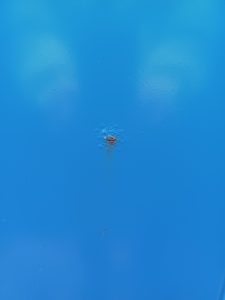Paint defects: What is blistering, what causes blistering and how can the risk of blistering be minimised?
What is blistering?
Blistering is a defect when bubbles form in the exterior decorative paint film that has been applied to a surface or primer and has failed to settle effectively. The subsequent lifting of the existing paint film from the underlying surface causes bubbles or blisters to show.
What are the causes of blistering?

This defect occurs when an element of air, water or grease between the topcoat and the previous layers of paint, lifts and swells the finish coat, generating the formation of blisters.
The main difference from the blisters with other types of defects is the characteristic circular shape without breaking of the finish paint.
This defect usually occurs in a layer of paint from the primer to the topcoat or between the substrate and first coat. This defect is usually observed once the paint has dried.
Dirt on the surface can act as moisture absorbing sponges, once heat is applied or they are exposed to certain temperatures, these particles expel water resulting in blisters.
Moisture absorption by the coating, either by lack of crosslinking during the curing process or by absorption of porous substrates prior to application of paint.
Osmosis phenomenon
Osmosis phenomenon through the paint layer salts on the substrate absorb moisture through the permeable paint film by osmosis so that it absorbs more water and produces the blisters.
Painting on very cold surfaces in comparison with the environment can cause issues too. If there is a high relative humidity, water (dew) particles form on the surface which generate blisters when the paint is applied.
Insufficient drying of the substrate or previous layer of paint which contains moisture prior to application of paint can cause it too.
The use of compressed air (without filtering) with traces of water, grease, contaminants, etc means this water or contaminants are deposited on the surface and forms blisters.
How can blistering be rectified?
It’s critical to apply and cure coating systems under correct environmental conditions. Follow the manufacturer’s recommendations on ambient conditions and overcoating times.
- Complete sanding the filler once dried, to avoid leaving occlusions of air during the curing process of the filler. Possibly use a suitable primer to seal the filler.
- Verify the proper drying of the paint layer.
- Clarify the absence of contaminants in the layer of paint.
- Perform periodic maintenance to the system of generation and supply of compressed air to ensure no water or oil is present.
- Select a coating with stronger adhesion properties and low moisture-vapour transfer rate MVT.
- Always consult paint manufacturer before commencing rework.
It’s possible that sometimes blistering can subside if left to cure but the problem could still return with environmental changes.
Once the paint has dried, sand the area containing the blistering until reaching the layer without blisters. Once reached re seal and refinish.
Blistering Standards
The evaluation of blistering is detailed in ISO 4628-2 and ASTM D714, both require the assessment of quantity (density) and size, as documented by good photographic records.
For more technical advice on working with industrial coatings, click here.